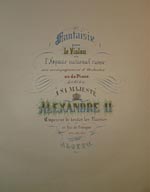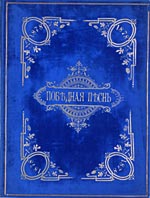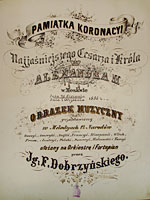Anthem of the Russian Empire
as a Gift to the Russian Emperors
Any presentation work to members of the Romanov Dynasty necessarily contain the author's address to a particular Emperor, placed on the title page of the manuscript. Citizens of the Russian Empire expressed the feelings of "loyalty and veneration", and foreign musicians stated "their deepest respect" to the Imperial persons.
Сomposers showed an attitude toward Russian Emperors not only in the dedication, but also in music. For this purpose, many of them used the anthem of the Russian Empire «God Save the Tsar!» by Alexey Lvov. For instance, Pyotr Tchaikovsky quoted the melody of the national anthem in six of his works.
The two virtuoso violinist: the Polish musician Isidor Lotto and the Russian one - July Gerber created works under similar titles. Lotto composed the «Fantasy for Violin on the Theme from the Russian National Anthem» with orchestra accompaniment (1861), Gerber produced «Grand Fantasia» for violin and orchestra (1886). Both of them have written compositions in the form of variations on a theme of the anthem. Lotto composed music in Leipzig (it was his first work - Op. 1) Gerber - in Russia.The French author Spiridion Karadja wrote a cantata, the first and last sections of which, entitled the «Prayer of the People», contain an extract from the melody of the anthem «God Save the Tsar!», played in the piano part. A section of the «Festival Overture» by Adolph Bauer, called «Patriotismus, Die Hymne, Gott erhalte den Kaiser» («The Patriotic Anthem "God Save the Tsar!"»), is also the arrangement of the music by the Alexey Lvov.
The cantor of the Jewish temple in Lemberg Jacob Bachmann, also interwove the thread of national anthem in the texture of his «Song of Triumph» for mixed choir and organ. In his work, the anthem by A. Lvov with the lyrics by Vasily Zhukovsky is performed in Russian, at the same time, it is "accompanied" by the psalm chanting in Hebrew.The composer Alexander Stattkowskÿ dedicacated his work «Joy in Moscow» to Alexander II's arrival in Moscow, which took place after a failed attempt on the Emperor's life in St. Petersburg by Dmitry Karakozov (on 4 April 1866). The third and final section of the piece is an arrangement of the Russian national anthem.
The Bavarian composer, violinist, and conductor Johann Valentin Hamm incorporated the anthem of the Russian Empire into the «Triumphal Symphony on the Russian National Anthem» presented to Alexander II during his visit to Bad Kissingen.
The French officer (Adjutant Captain) Joseph Bazin quoted the anthem in the introduction to the «Grand Festive Waltz» and in the «Grand Triumphant Waltz». And in the second composition, the Russian anthem is combined with the French «Marseillaise».
It is worth to be mentioned about the composition of the Polish pianist, composer, conductor Feliks Dobrzyński. His suite «Musical Pictures of the Twelve Nations» consists of an introduction and a series of 12 tunes popular in different countries, arranged by Dobrzyński. Each piece has a title with the name of a specific country. America was represented by the national song «Yankee-Doodle», England - by patriotic song «Rule, Britannia!», France - by the popular in the 19th century song «Partant Pour La Syrie», Spain and Italy - by dances «Bolero» and «Tarantella», Austria - by Hungarian dances («Taniec Wegerski»), Prussia - by «Dessauer Marsch», Poland -by «Taniec Polski», Sweden and Holland - by «Piesni», a musical picture, representing Turkey, was without name. The last piece of the suite is an arrangement of the National Anthem of Russia - «God Save the Tsar» by A. Lvov.This is not all names of composers who have made use of the tune of the national anthem «God Save the Tsar». It can be found in other manuscripts collection in one form or another. So frequent reference to the hymn was initiated by different motives. For Russian musicians, the anthem was not only an expression of the feeling of loyalty. It implied the traditional prayer for the tsar, dating back to the age of Russian Middle Ages, when church hymns included petition for 'wellness of the monarch and victory over enemies' of Russia. The prayer was expressed through musical and poetic means, contempory to authors. By inserting a hymn in their compositions, foreign musicians sought to demonstrate knowledge of the musical symbol of the Russian state and a respectful attitude towards it. At the same time, all composers tryed to show their skills, arranging the theme of this very popular tune, varying it or "weaving" it in the musical fabric of their works. interwove the thread of national anthem in the texture.
At the end of the review of manuscripts presented in electronic version, it should be noted that they are of unequal value. Here you can find the names of famous composers, who gained an international reputation; ones celebrated in their time, but sometimes undeservedly forgotten; as well as complete unknown musicians. Not all the works are high artistic merit. The online access to the electronic versions of the manuscripts allows each to independently assess the musical merit of the works, and possibly, performers to expand their repertoire.
The collection of music gifts is a certain stratum of both Russian and world culture. It reflects the tradition of paying tributes to the first persons of the state.


